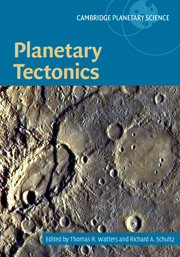Book contents
- Frontmatter
- Contents
- List of contributors
- Preface
- 1 Planetary tectonics: introduction
- 2 The tectonics of Mercury
- 3 Venus tectonics
- 4 Lunar tectonics
- 5 Mars tectonics
- 6 Tectonics of small bodies
- 7 Tectonics of the outer planet satellites
- 8 Planetary structural mapping
- 9 Strength and deformation of planetary lithospheres
- 10 Fault populations
- Index
- Plates
- References
8 - Planetary structural mapping
Published online by Cambridge University Press: 30 March 2010
- Frontmatter
- Contents
- List of contributors
- Preface
- 1 Planetary tectonics: introduction
- 2 The tectonics of Mercury
- 3 Venus tectonics
- 4 Lunar tectonics
- 5 Mars tectonics
- 6 Tectonics of small bodies
- 7 Tectonics of the outer planet satellites
- 8 Planetary structural mapping
- 9 Strength and deformation of planetary lithospheres
- 10 Fault populations
- Index
- Plates
- References
Summary
Summary
As on Earth, other solid-surfaced planetary bodies in the solar system display landforms produced by tectonic activity, such as faults, folds, and fractures. These features are resolved in spacecraft observations directly or with techniques that extract topographic information from a diverse suite of data types, including radar backscatter and altimetry, visible and near-infrared images, and laser altimetry. Each dataset and technique has its strengths and limitations that govern how to optimally utilize and properly interpret the data and what sizes and aspects of features can be recognized. The ability to identify, discriminate, and map tectonic features also depends on the uniqueness of their form, on the morphologic complexity of the terrain in which the structures occur, and on obscuration of the features by erosion and burial processes. Geologic mapping of tectonic structures is valuable for interpretation of the surface strains and of the geologic histories associated with their formation, leading to possible clues about: (1) the types or sources of stress related to their formation, (2) the mechanical properties of the materials in which they formed, and (3) the evolution of the body's surface and interior where timing relationships can be determined. Formal mapping of tectonic structures has been performed and/or is in progress for Earth's Moon, the planets Mars, Mercury, and Venus, and the satellites of Jupiter (Callisto, Ganymede, Europa, and Io).
- Type
- Chapter
- Information
- Planetary Tectonics , pp. 351 - 396Publisher: Cambridge University PressPrint publication year: 2009
References
- 2
- Cited by

